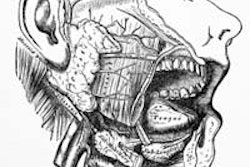
Heavy cellphone use increases the rate of saliva and flow, as well as the volume of parotid glands, according to a study to be published next month in Oral Surgery, Oral Medicine, Oral Pathology, Oral Radiology (August 2012, Vol. 114:2, pp. 200-206).
Researchers from the department of oral medicine and radiology at Vidya Shikshan Prasarak Mandal's Dental College and Research Centre in India were interested in looking at how heat and radiofrequency radiation that cellphones emit can impact adjacent tissues.
"Mobile phones are known to generate heat and emit radiofrequency radiation in the form of nonionizing electromagnetic radiations in the range of 800-2,200 MHz, similar to many home appliances," they wrote. "But the long duration and proximity of mobile phones to human body during use has given rise to concerns of possible adverse effects resulting from absorption of these emissions by the tissues adjacent to the area of mobile phone handset use."
Because the parotid glands are located in front of the ear in close proximity to where cellphones are held when in use, these glands in particular could be vulnerable to adverse effects, the study authors noted.
Previous studies have had considerable variation in their conclusions, suggesting or denying a correlation between heavy cellphone use and headaches, migraines, brain tumors, auditory canal pathologies, and physiologic changes in the salivary glands, they noted.
For example, a nationwide case-control study performed at the Gertner Institute at Chaim Sheba Medical Center found what is believed to be a link between heavy cellphone use and malignant tumors in the parotid gland (PGT) (American Journal of Epidemiology, December 2007, Vol. 167:4, pp. 457-467). "Based on the largest number of benign PGT patients reported to date, our results suggest an association between cellular phone use and PGTs," the researchers wrote.
The researchers examined 402 benign and 58 malignant cases of PGTs discovered in Israel from 2001 through 2003 in people age 18 or older, plus 1,266 individually matched controls.
For the entire group, no increased risk of PGTs was observed for ever having been a regular cellphone user (odds ratio = 0.87; p = 0.3) or for any other measure of exposure investigated, they found. But when they restricted their analysis to regular cellphone users to conditions that can lead to higher amounts of exposure, such as heavy use in rural areas, they noted "consistently elevated risks."
Dominant vs. nondominant
For this study, the researchers recruited 142 healthy men and women between the ages of 18 and 30 who had used mobile phones for three or more years. The participants had no oral complaints, disorders, or medication use that could affect salivation, nor did they have a history of systemic disorders affecting the head, neck, or face.
Group I, the heavy-user group, consisted of 50 men and 50 women who used their phones for more than two hours per day on average. Group II, which served as the control, comprised 20 men and 22 women who used their phones for less than two hours per day. None of the study participants used a hands-free device.
One week prior to the study, the participants were asked to log their typical cellphone usage habits. They were also tested for salivary flow rate using a modified Schirmer's test between 9 a.m. and 1 p.m. after being instructed not to eat or drink anything but water for two hours prior to the test. The researchers wanted to test the parotid glands in their resting state, so they asked participants to relax for five minutes before gathering salivary flow rate data.
They compared the saliva flow for both the dominant and nondominant sides of all study participants; the side of the participants' head where he or she typically held the phone was considered the dominant side in both groups.
For individuals showing an increase of 1.5 mL/5 min or greater in salivary flow rate of the dominant side compared with the nondominant side, the modified Schirmer's test was repeated on two consecutive days and the average score recorded, the researchers wrote.
Additional tests
The researchers also performed ultrasonography of the superior lobe of the parotid bilaterally in the subjects who displayed greater salivary flow on the dominant side. The superior lobe was chosen due to its anatomic location relative to where cellphones are held when in use.
Next, they completed a statistical analysis of the data, with a p-value of 0.05 or less considered statistically significant. They found that the heavy-user group had a higher rate of salivation on the dominant side at 4.35 ± 3.03 mm/5 min versus 3.4 ± 1.64 mm/5 min on the nondominant side. The dominant side of the control group averaged 3.1 ± 0.3 mm/5 min while the nondominant side was 2.85 ± 0.29 mm/5 min.
"Group I showed 26% more parotid salivation on the dominant side compared with the nondominant side (p < 0.00001)," the researchers wrote. "In contrast, group II showed 8% more salivary flow rate on the dominant side than on the nondominant side (p = 0.562)."
The researchers also observed 13% more average volume of the superior lobe of parotid on the dominant side versus the nondominant side; the difference was only 6% between the dominant and nondominant sides of the control group.
From the present study, "functional and volumetric changes induced in parotid glands are associated with excessive mobile phone use," the researchers concluded.
Interestingly, 30% of the participants reported other problems experienced after cellphone use: 35 reported ringing and heating of the ear and skin, 7 reported headaches, and 5 said they suffered from migraines.
In addition, a failed attempt to measure salivary flow velocity with color Doppler imaging "allowed us to discover that the velocity of blood flow of the external carotid artery within the parotid gland of the dominant side was more than that of the other side, by almost 1.5-fold, in 20 of 38 USG [ultrasound] participants," the researchers wrote. Both Global System for Mobile Communications (GSM) users (68%) and Code Division Multiple Access (CDMA) users (32%) showed increases in salivary flow rate and volume of parotid gland, they noted.
Radiofrequency radiation and heat generated by the phones are possible causes for changes in their users, according to the study authors. Other studies have found that radiofrequency radiation from phones can have an effect.
"Longer use of mobiles can potentially raise skin temperature and increase perfusion of the tissue to reduce the raised temperatures," the researchers wrote.



















